Enzymatic Degradation of Organophosphorus Pesticides and Nerve Agents by EC: 3.1.8.2
Abstract
1. Introduction
2. History of EC: 3.1.8.2
3. Squid-Type DFPase
3.1. Structure
3.2. Mechanism of Action
3.3. Substrate Profile
4. OPAA from Alteromonas
4.1. Structure
4.2. Mechanism of Action
4.3. Substrate Profile
5. Adapting Enzyme EC: 3.1.8.2 for Nerve Agent Decontamination
6. Practical Use of EC: 3.1.8.2
7. Conclusions
Author Contributions
Funding
Conflicts of Interest
Abbreviations
| CWA | chemical warfare agents |
| DDFP | N,N′-diisopropyl phosphorodiamidofluoridate |
| DFP | diisopropyl fluorophosphate |
| DFPase | diisopropyl fluorophosphatase |
| EC | Enzyme Commission number |
| GP | 2,2-dimethylcyclopentyl methylphosphonofluoridate |
| NA | nerve agents |
| OP | organophosphorus compounds |
| OPAA | organophosphorus anhydrolase |
| OPH | organophosphorus hydrolase |
| PEG | polyethylene glycol |
| PTE | phosphotriesterase |
| VR | Russian VX/N,N-diethyl-2-(methyl-(2-methylpropoxy)phosphoryl)sulfanylethanamine |
| VX | S-[2-(Diisopropylamino)ethyl]-O-ethyl methylphosphonothioate |
| WT | wild-type |
References
- Linthorst, J.A. An overview: Origins and development of green chemistry. Found. Chem. 2009, 12, 55–68. [Google Scholar] [CrossRef]
- Dvořák, J.; Melkes, V. Ekologické Havárie a Dekontaminace Znečištění; Vysoká vojenská škola pozemního vojska: Vyškov, Czech Republic, 1997. [Google Scholar]
- Mulchandani, A.; Kaneva, I.; Chen, W. Detoxification of organophosphate nerve agents by immobilizedEscherichia coli with surface-expressed organophosphorus hydrolase. Biotechnol. Bioeng. 1999, 63, 216–223. [Google Scholar] [CrossRef]
- Ghanem, E.; Raushel, F.M. Detoxification of organophosphate nerve agents by bacterial phosphotriesterase. Toxicol. Appl. Pharmacol. 2005, 207, 459–470. [Google Scholar] [CrossRef] [PubMed]
- Singh, B.K.; Walker, A. Microbial degradation of organophosphorus compounds. FEMS Microbiol. Rev. 2006, 30, 428–471. [Google Scholar] [CrossRef]
- WHO. Public Health Impact of Pesticides used in Agriculture; World Health Organization: Geneva, Switzerland, 1990. [Google Scholar]
- Las, B.R. Southeast Asia: A Potential Domain for Chemical Terrorism; Missouri State University: Springfield, MA, USA, 2019. [Google Scholar]
- DeFrank, J. Catalytic Enzyme-Based Methods for Water Treatment and Water Distribution System Decontamination; U.S. Army Edgewood Chemical Biological Center, Aberdeen Proving Ground: Gunpowder, MD, USA, 2006. [Google Scholar]
- UN Security Council. Report of the OPCW Fact-Finding Mission in Syria Regarding an Alleged Incident in Khan Shaykhun, Syrian Arab Republic April 2017 (S/2017/567) [EN/AR]. 2017. Available online: https://reliefweb.int/report/syrian-arab-republic/report-opcw-fact-finding-mission-syria-regarding-alleged-incident-khan (accessed on 1 August 2020).
- Rosman, Y.; Eisenkraft, A.; Milk, N.; Shiyovich, A.; Ophir, N.; Shrot, S.; Kreiss, Y.; Kassirer, M. Lessons Learned From the Syrian Sarin Attack: Evaluation of a Clinical Syndrome Through Social Media. Ann. Intern. Med. 2014, 160, 644–648. [Google Scholar] [CrossRef]
- BBC News. Kim Jong-Nam ’Killed by VX Nerve Agent’. 2017. Available online: https://www.bbc.com/news/world-asia-39073389 (accessed on 1 August 2020).
- OPCW. The Sarin Gas Attack in Japan and the Related Forensic Investigation. Available online: https://www.opcw.org/media-centre/news/2001/06/sarin-gas-attack-japan-and-related-forensic-investigation,2001 (accessed on 1 August 2020).
- OPCW. Incident in Salisbury. 2018. Available online: https://www.opcw.org/media-centre/featured-topics/incident-salisbury (accessed on 1 August 2020).
- Peplow, M. Nerve Agent Attack on Spy Used ‘Novichok’ Poison. 2018. Available online: https://cen.acs.org/articles/96/i12/Nerve-agent-attack-on-spy-used-Novichok-poison.html (accessed on 1 August 2020).
- Nepovimova, E.; Kuča, K. Chemical warfare agent NOVICHOK-mini-review of available data. Food Chem. Toxicol. 2018, 121, 343–350. [Google Scholar] [CrossRef]
- Chen, W.; Richins, R.D.; Mulchandani, P.; Kaneva, I.; Mulchandani, A. Biodegradation of organophosphorus nerve agents by surface expressed organophosphorus hydrolase. In Enzymes in Action; Springer Science and Business Media LLC: Dordrecht, The Netherlands, 2000; pp. 211–221. [Google Scholar]
- Singh, B.K. Organophosphorus-degrading bacteria: Ecology and industrial applications. Nat. Rev. Genet. 2009, 7, 156–164. [Google Scholar] [CrossRef]
- Hoskin, F.C.; Walker, J.E.; Stote, R. Degradation of nerve gases by CLECS and cells: Kinetics of heterogenous systems. Chem. Interact. 1999, 119, 439–444. [Google Scholar] [CrossRef]
- Schofield, D.A.; DiNovo, A. Generation of a mutagenized organophosphorus hydrolase for the biodegradation of the organophosphate pesticides malathion and demeton-S. J. Appl. Microbiol. 2010, 109, 548–557. [Google Scholar] [CrossRef]
- Raushel, F.M. Bacterial detoxification of organophosphate nerve agents. Curr. Opin. Microbiol. 2002, 5, 288–295. [Google Scholar] [CrossRef]
- Theriot, C.M.; Grunden, A.M. Hydrolysis of organophosphorus compounds by microbial enzymes. Appl. Microbiol. Biotechnol. 2011, 89, 35–43. [Google Scholar] [CrossRef]
- Richardt, A.; Blum, M.-M. Decontamination of Warfare Agents; Wiley-VCH: Weinheim, Germany, 2008. [Google Scholar]
- Dave, K.I.; Miller, C.E.; Wild, J.R. Characterization of organophosphorus hydrolases and the genetic manipulation of the phosphotriesterase from Pseudomonas diminuta. Chem. Interact. 1993, 87, 55–68. [Google Scholar] [CrossRef]
- DeFrank, J.J.; White, W.E. Phosphofluoridates: Biological Activity and Biodegradation; Springer Science and Business Media LLC: Dordrecht, The Netherlands, 2006; pp. 295–343. [Google Scholar]
- Bigley, A.N.; Raushel, F.M. The evolution of phosphotriesterase for decontamination and detoxification of organophosphorus chemical warfare agents. Chem. Interact. 2019, 308, 80–88. [Google Scholar] [CrossRef] [PubMed]
- Prokop, Z.; Opluštil, F.; DeFrank, J.; Damborsky, J. Enzymes fight chemical weapons. Biotechnol. J. 2006, 1, 1370–1380. [Google Scholar] [CrossRef] [PubMed]
- Mazur, A. An enzyme in animal tissues capable of hydrolyzing the phosphorus-fluorine bond of alkyl fluorophosphates. J. Biol. Chem. 1946, 164, 271–289. [Google Scholar] [PubMed]
- Clancy, J.; McVicar, A.; Ellison, D.H. Handbook of Chemical and Biological Warfare Agents; Informa UK Limited: Colchester, UK, 2007. [Google Scholar]
- Mounter, L.A.; Floyd, C.S.; Chanutin, A. Dialkylfluorophosphatase of kidney. I. Purification and properties. J. Biol. Chem. 1953, 204, 221–232. [Google Scholar] [PubMed]
- Mounter, L.A. The complex nature of dialkylfluorophosphatases of hog and rat liver and kidney. J. Biol. Chem. 1955, 215, 705–711. [Google Scholar]
- Mounter, L.A.; Dien, L.T.; Chanutin, A. The distribution of dialkylfluorophosphatases in the tissues of various species. J. Biol. Chem. 1955, 215, 691–697. [Google Scholar] [PubMed]
- Mounter, L.A.; Dien, L.T. Dialkylfluorophosphatase of kidney. V. The hydrolysis of organophosphorus compounds. J. Biol. Chem. 1956, 219, 685–690. [Google Scholar]
- Mounter, L.A.; Tuck, K.D. Dialkylfluorophosphatases of microorganisms. II. Substrate specificity studies. J. Biol. Chem. 1956, 221, 537–541. [Google Scholar]
- Mounter, L.A.; Baxter, R.F.; Chanutin, A. Dialkylfluorophosphatases of microorganisms. J. Biol. Chem. 1955, 215, 699–704. [Google Scholar] [PubMed]
- Aldridge, W.N. Serum esterases. 1. Two types of esterase (A and B) hydrolysing p-nitrophenyl acetate, propionate and butyrate, and a method for their determination. Biochem. J. 1953, 53, 110–117. [Google Scholar] [CrossRef] [PubMed]
- Aldridge, W.N. Serum esterases. 2. An enzyme hydrolysing diethyl p-nitrophenyl phosphate (E 600) and its identity with the A-esterase of mammalian sera. Biochem. J. 1953, 53, 117–124. [Google Scholar] [CrossRef] [PubMed]
- Augustinsson, K.-B.; Heimbürger, G.; Roine, P.; Sörensen, N.A. Enzymic Hydrolysis of Organophosphorus Compounds. I. Occurrence of Enzymes Hydrolyzing Dimethyl-amido-ethoxy-phosphoryl Cyanide (Tabun). Acta Chem. Scand. 1954, 8, 753–761. [Google Scholar] [CrossRef][Green Version]
- Augustinsson, K.-B.; Heimbürger, G.; Risberg, E.; Lamm, O. Enzymatic Hydrolysis of Organophosphorus Compounds. VI. Effect of Metallic Ions on the Phosphorylphosphatases of Human Serum and Swine Kidney. Acta Chem. Scand. 1955, 9, 383–392. [Google Scholar] [CrossRef]
- Augustinsson, K.-B.; Studnitz, W.V.; Bergson, G.; Grönvall, A.; Zaar, B.; Diczfalusy, E. Enzymic Hydrolysis of Organophosphorus Compounds. VIII. Effect of Anions. Acta Chem. Scand. 1958, 12, 1286–1291. [Google Scholar] [CrossRef]
- Augustinsson, K.-B.; Kulonen, E.; Hevesy, G.; Schliack, J.; Reio, L. Enzymatic Hydrolysis of Organophosphorus Compounds. VII. The Stereospecificity of Phosphorylphosphatases. Acta Chem. Scand. 1957, 11, 1371–1377. [Google Scholar] [CrossRef]
- Augustinsson, K.-B.; Heimbürger, G.; Vihovde, J.; Sörensen, N.A. Enzymic Hydrolysis of Organophosphorus Compounds. IV. Specificity Studies. Acta Chem. Scand. 1954, 8, 1533–1541. [Google Scholar] [CrossRef]
- Augustinsson, K.-B.; Heimbürger, G.; Ingri, N.; Lamm, O. Enzymatic Hydrolysis of Organophosphorus Compounds. V. Effect of Phosphorylphosphatase on the Inactivation of Cholinesterases by Organophosphorus Compounds in vitro. Acta Chem. Scand. 1955, 9, 310–318. [Google Scholar] [CrossRef]
- Hoskin, F.C.G. Possible Significance of “DFPase“ in Squid Nerve. Biol. Bull. Mar. Biol. Lab. 1969, 137, 389–390. [Google Scholar]
- Hoskin, F.C.G. Diisopropylphosphorofluoridate and Tabun: Enzymatic Hydrolysis and Nerve Function. Science 1971, 172, 1243–1245. [Google Scholar] [CrossRef] [PubMed]
- Hoskin, F.C.; Roush, A.H. Hydrolysis of nerve gas by squid-type diisopropyl phosphorofluoridate hydrolyzing enzyme on agarose resin. Science 1982, 215, 1255–1257. [Google Scholar] [CrossRef]
- Hartleib, J.; Rüterjans, H. High-Yield Expression, Purification, and Characterization of the Recombinant Diisopropylfluorophosphatase from Loligo vulgaris. Protein Expr. Purif. 2001, 21, 210–219. [Google Scholar] [CrossRef] [PubMed]
- Hartleib, J.; Rüterjans, H. Insights into the reaction mechanism of the diisopropyl fluorophosphatase from Loligo vulgaris by means of kinetic studies, chemical modification and site-directed mutagenesis. Biochim. Biophys. Acta BBA Protein Struct. Mol. Enzym. 2001, 1546, 312–324. [Google Scholar] [CrossRef]
- Hartleib, J.; Geschwindner, S.; Scharff, E.I.; Rüterjans, H. Role of calcium ions in the structure and function of thedi-isopropylfluorophosphatase from Loligo vulgaris. Biochem. J. 2001, 353, 579. [Google Scholar] [CrossRef]
- Scharff, E.I.; Lücke, C.; Fritzsch, G.; Koepke, J.; Hartleib, J.; Dierl, S.; Rüterjans, H. Crystallization and preliminary X-ray crystallographic analysis of DFPase from Loligo vulgaris. Acta Crystallogr. Sect. D Biol. Crystallogr. 2001, 57, 148–149. [Google Scholar] [CrossRef] [PubMed]
- Scharff, E.I.; Koepke, J.; Fritzsch, G.; Lücke, C.; Rüterjans, H. Crystal structure of diisopropylfluorophosphatase from Loligo vulgaris. Structure 2001, 9, 493–502. [Google Scholar] [CrossRef]
- Landis, W.G.; Savage, R.E.; Hoskin, F.C.G. An Organofluorophosphate-Hydrolyzing Activity inTetrahymena thermophila1. J. Protozool. 1985, 32, 517–519. [Google Scholar] [CrossRef]
- Landis, W.G.; Haley, M.V.; Johnson, D.W. Kinetics of the DFPase Activity inTetrahymena thermophila1. J. Protozool. 1986, 33, 216–218. [Google Scholar] [CrossRef]
- Landis, W.G.; Haley, D.M.; Haley, M.V.; Johnson, D.W.; Durst, H.D.; Savage, R.E. Discovery of multiple organofluorophosphate hydrolyzing activities in the protozoanTetrahymena thermophila. J. Appl. Toxicol. 1987, 7, 35–41. [Google Scholar] [CrossRef]
- Anderson, R.; Durst, H.; Landis, W. Organofluorophosphate-hydrolyzing activity in an estuarine clam, Rangia cuneata. Comp. Biochem. Physiol. Part C Comp. Pharmacol. 1988, 91, 575–578. [Google Scholar] [CrossRef]
- Anderson, R.S.; Durst, H.D.; Landis, W.G. Initial characterization of an OPA anhydrase in the clam, Rangia cuneata. Comp. Biochem. Phys. 1988, 91C, 575–578. [Google Scholar]
- Attaway, H.; Nelson, O.J.; Baya, A.M.; Voll, M.J.; White, E.W.; Grimes, D.J.; Colwell, R.R. Bacterial detoxification of diisopropyl fluorophosphate. Appl. Environ. Microbiol. 1987, 53, 1685–1689. [Google Scholar] [CrossRef] [PubMed]
- Hoskin, F.C.G.; Kirkish, M.A.; Steinmann, K.E. Two Enzymes for the Detoxicatlon of Organophosphorus Compounds—Sources, Similarities, and Significance. Toxicol. Sci. 1984, 4, 165–172. [Google Scholar] [CrossRef]
- Nachmansohn, D.; Neumann, E. Chemical and Molecular Basis of Nerve Activity; Elsevier: Amsterdam, The Netherlands, 1975. [Google Scholar]
- Hoskin, F.C.; Rosenberg, P.; Brzin, M. Re-examination of the effect of DFP on electrical and cholinesterase activity of squid giant axon. Proc. Natl. Acad. Sci. USA 1966, 55, 1231–1235. [Google Scholar] [CrossRef] [PubMed]
- Hoskin, F.C.; Long, R.J. Purification of a DFP-hydrolyzing enzyme from squid head ganglion. Arch. Biochem. Biophys. 1972, 150, 548–555. [Google Scholar] [CrossRef]
- Garden, J.M.; Hause, S.K.; Hoskin, F.C.; Roush, A.H. Comparison of DFP-hydrolyzing enzyme purified from head ganglion and hepatopancreas of squid (Loligo pealei) by means of isoelectric focusing. Comp. Biochem. Physiol. Part C Comp. Pharmacol. 1975, 52, 95–98. [Google Scholar] [CrossRef]
- Koepke, J.; Scharff, E.I.; Lücke, C.; Rüterjans, H.; Fritzsch, G. Statistical analysis of crystallographic data obtained from squid ganglion DFPase at 0.85 A resolution. Acta Crystallogr. Sect. D Biol. Crystallogr. 2003, 59, 1744–1754. [Google Scholar] [CrossRef]
- Melzer, M.; Chen, J.C.-H.; Heidenreich, A.; Gäb, J.; Koller, M.; Kehe, K.; Blum, M.-M. Reversed Enantioselectivity of Diisopropyl Fluorophosphatase against Organophosphorus Nerve Agents by Rational Design. J. Am. Chem. Soc. 2009, 131, 17226–17232. [Google Scholar] [CrossRef]
- Cohen, J.; Warringa, M. Purification and properties of dialkylfluorophosphatase. Biochim. Biophys. Acta BBA Bioenerg. 1957, 26, 29–39. [Google Scholar] [CrossRef]
- Deschamps, J.R.; Kopec-Smyth, K.; Poppino, J.L.; Futrovsky, S.L.; Ward, K. Comparison of organophosphorous acid anhydrolases from different species using monoclonal antibodies. Comp. Biochem. Physiol. Part C Pharmacol. Toxicol. Endocrinol. 1993, 106, 765–768. [Google Scholar] [CrossRef]
- Allahyari, H.; Latifi, A.M. Diisopropyl-fluorophosphatase as a catalytic bioscavenger. Appl. Biotechnol. Rep. 2016, 3, 477–482. [Google Scholar]
- Chemnitius, J.-M.; Losch, H.; Losch, K.; Zech, R. Organophosphate detoxicating hydrolases in different vertebrate species. Comp. Biochem. Physiol. Part C Comp. Pharmacol. 1983, 76, 85–93. [Google Scholar] [CrossRef]
- Bigley, A.N.; Raushel, F.M. Catalytic mechanisms for phosphotriesterases. Biochim. Biophys. Acta BBA Proteins Proteom. 2013, 1834, 443–453. [Google Scholar] [CrossRef] [PubMed]
- Katsemi, V.; Lücke, C.; Koepke, J.; Lohr, F.; Maurer, S.; Fritzsch, G.; Rüterjans, H. Mutational and Structural Studies of the Diisopropylfluorophosphatase fromLoligo vulgarisShed New Light on the Catalytic Mechanism of the Enzyme†. Biochemistry 2005, 44, 9022–9033. [Google Scholar] [CrossRef] [PubMed]
- Blum, M.-M.; Chen, J.C.-H. Structural characterization of the catalytic calcium-binding site in diisopropyl fluorophosphatase (DFPase)—Comparison with related β-propeller enzymes. Chem. Interact. 2010, 187, 373–379. [Google Scholar] [CrossRef] [PubMed]
- Chen, J.C.-H.; Mustyakimov, M.; Schoenborn, B.P.; Langan, P.; Blum, M.-M. Neutron structure and mechanistic studies of diisopropyl fluorophosphatase (DFPase). Acta Crystallogr. Sect. D Biol. Crystallogr. 2010, 66, 1131–1138. [Google Scholar] [CrossRef]
- Elias, M.; Liebschner, D.; Koepke, J.; LeComte, C.; Guillot, B.; Jelsch, C.; Chabriere, E. Hydrogen atoms in protein structures: High-resolution X-ray diffraction structure of the DFPase. BMC Res. Notes 2013, 6, 308. [Google Scholar] [CrossRef]
- Xu, C.; Yang, L.; Yu, J.-G.; Liao, R.-Z. What roles do the residue Asp229 and the coordination variation of calcium play of the reaction mechanism of the diisopropyl-fluorophosphatase? A DFT investigation. Theor. Chem. Acc. 2016, 135, 138. [Google Scholar] [CrossRef]
- Blum, M.-M.; Lohr, F.; Richardt, A.; Rüterjans, H.; Chen, J.C.-H. Binding of a Designed Substrate Analogue to Diisopropyl Fluorophosphatase: Implications for the Phosphotriesterase Mechanism. J. Am. Chem. Soc. 2006, 128, 12750–12757. [Google Scholar] [CrossRef]
- Soares, F.V.; De Castro, A.A.; Pereira, A.F.; Leal, D.H.S.; Mancini, D.T.; Krejcar, O.; Kuca, K.; Da Cunha, E.F.; Kuca, K. Theoretical Studies Applied to the Evaluation of the DFPase Bioremediation Potential against Chemical Warfare Agents Intoxication. Int. J. Mol. Sci. 2018, 19, 1257. [Google Scholar] [CrossRef] [PubMed]
- Wymore, T.; Field, M.J.; Langan, P.; Smith, J.C.; Parks, J.M. Hydrolysis of DFP and the Nerve Agent (S)-Sarin by DFPase Proceeds along Two Different Reaction Pathways: Implications for Engineering Bioscavengers. J. Phys. Chem. B 2014, 118, 4479–4489. [Google Scholar] [CrossRef] [PubMed]
- Blum, M.-M.; Mustyakimov, M.; Rüterjans, H.; Kehe, K.; Schoenborn, B.P.; Langan, P.; Chen, J.C.-H. Rapid determination of hydrogen positions and protonation states of diisopropyl fluorophosphatase by joint neutron and X-ray diffraction refinement. Proc. Natl. Acad. Sci. USA 2009, 106, 713–718. [Google Scholar] [CrossRef] [PubMed]
- Hoskin, F.C.; Prusch, R.D. Characterization of a DFP-hydrolyzing enzyme in squid posterior salivary gland by use of soman, DFP and manganous ion. Comp. Biochem. Physiol. Part C Comp. Pharmacol. 1983, 75, 17–20. [Google Scholar] [CrossRef]
- Blum, M.-M.; Timperley, C.M.; Williams, G.R.; Thiermann, H.; Worek, F. Inhibitory Potency against Human Acetylcholinesterase and Enzymatic Hydrolysis of Fluorogenic Nerve Agent Mimics by Human Paraoxonase 1 and Squid Diisopropyl Fluorophosphatase. Biochemistry 2008, 47, 5216–5224. [Google Scholar] [CrossRef] [PubMed]
- DeFrank, J.J.; Cheng, T.C. Purification and properties of an organophosphorus acid anhydrase from a halophilic bacterial isolate. J. Bacteriol. 1991, 173, 1938–1943. [Google Scholar] [CrossRef] [PubMed][Green Version]
- DeFrank, J.J.; Beaudry, W.T.; Cheng, T.-C.; Harvey, S.P.; Stroup, A.N.; Szafraniec, L.L. Screening of halophilic bacteria and Alteromonas species for organophosphorus hydrolyzing enzyme activity. Chem. Interact. 1993, 87, 141–148. [Google Scholar] [CrossRef]
- Cheng, T.-C.; Liu, L.; Wang, B.; Wu, J.; DeFrank, J.J.; Anderson, D.M.; Rastogi, V.K.; Hamilton, A.B. Nucleotide sequence of a gene encoding an organophosphorus nerve agent degrading enzyme from Alteromonas haloplanktis. J. Ind. Microbiol. Biotechnol. 1997, 18, 49–55. [Google Scholar] [CrossRef]
- Cheng, T.-C.; Harvey, S.P.; Stroup, A.N. Purification and Properties of a Highly Active Organophosphorus Acid Anhydrolase from Alteromonas undina. Appl. Environ. Microbiol. 1993, 59, 3138–3140. [Google Scholar] [CrossRef]
- Cheng, T.-C.; DeFrank, J.J. Hydrolysis of Organophosphorus Compounds by Bacterial Prolidases. Enzymes Action 2000, 243–261. [Google Scholar] [CrossRef]
- Vyas, N.K.; Nickitenko, A.; Rastogi, V.K.; Shah, S.S.; Quiocho, F.A. Structural Insights into the Dual Activities of the Nerve Agent Degrading Organophosphate Anhydrolase/Prolidase. Biochemistry 2010, 49, 547–559. [Google Scholar] [CrossRef] [PubMed]
- Cheng, T.C.; DeFrank, J.J.; Rastogi, V.K. Alteromonas prolidase for organophosphorus G-agent decontamination. Chem. Interact. 1999, 119, 455–462. [Google Scholar] [CrossRef]
- Cheng, T.C.; Harvey, S.P.; Chen, G.L. Cloning and expression of a gene encoding a bacterial enzyme for decontamination of organophosphorus nerve agents and nucleotide sequence of the enzyme. Appl. Environ. Microbiol. 1996, 62, 1636–1641. [Google Scholar] [CrossRef] [PubMed]
- Daczkowski, C.M.; Pegan, S.D.; Harvey, S.P. Engineering the Organophosphorus Acid Anhydrolase Enzyme for Increased Catalytic Efficiency and Broadened Stereospecificity on Russian VX. Biochemistry 2015, 54, 6423–6433. [Google Scholar] [CrossRef] [PubMed]
- Kitchener, R.; Grunden, A. Prolidase function in proline metabolism and its medical and biotechnological applications. J. Appl. Microbiol. 2012, 113, 233–247. [Google Scholar] [CrossRef]
- Hill, C.M.; Wu, F.; Cheng, T.-C.; DeFrank, J.J.; Raushel, F.M. Substrate and stereochemical specificity of the organophosphorus acid anhydrolase from Alteromonas sp. JD6.5 toward p-nitrophenyl phosphotriesters. Bioorg. Med. Chem. Lett. 2000, 10, 1285–1288. [Google Scholar] [CrossRef]
- Hill, C.M.; Li, W.-S.; Cheng, T.-C.; DeFrank, J.J.; Raushel, F.M. Stereochemical Specificity of Organophosphorus Acid Anhydrolase toward p-Nitrophenyl Analogs of Soman and Sarin. Bioorg. Chem. 2001, 29, 27–35. [Google Scholar] [CrossRef]
- Harvey, S.P.; McMahon, L.R.; Berg, F.J. Hydrolysis and enzymatic degradation of Novichok nerve agents. Heliyon 2020, 6, e03153. [Google Scholar] [CrossRef]
- Lukey, B.J.; Romano, J.A.; Harry, S. Chemical Warfare Agents; Informa UK Limited: Colchester, UK, 2019. [Google Scholar]
- Bae, S.Y.; Myslinski, J.M.; McMahon, L.R.; Height, J.J.; Bigley, A.N.; Raushel, F.M.; Harvey, S.P. An OPAA enzyme mutant with increased catalytic efficiency on the nerve agents sarin, soman, and GP. Enzym. Microb. Technol. 2018, 112, 65–71. [Google Scholar] [CrossRef]
- Lejeune, K.E.; Russell, A.J. Biocatalytic nerve agent detoxification in fire fighting foams. Biotechnol. Bioeng. 1999, 62, 659–665. [Google Scholar] [CrossRef]
- Drevon, G.F.; Russell, A.J. Irreversible immobilization of diisopropylfluorophosphatase in polyurethane polymers. Biomacromolecules 2000, 1, 571–576. [Google Scholar] [CrossRef] [PubMed]
- Danielmeier, K.; Federspiel, W.; Stolz, N.B.; Wicks, D.A.; Yu, P.C.; Russell, A.J.; Drevon, G.F. High-activity enzyme-polyurethane coatings. Biotechnol. Bioeng. 2002, 79, 785–794. [Google Scholar] [CrossRef]
- Furukawa, H.; Cordova, K.E.; O’Keeffe, M.; Yaghi, O.M. The Chemistry and Applications of Metal-Organic Frameworks. Science 2013, 341, 1230444. [Google Scholar] [CrossRef] [PubMed]
- Li, P.; Moon, S.-Y.; Guelta, M.A.; Lin, L.; Gómez-Gualdrón, D.A.; Snurr, R.Q.; Harvey, S.P.; Hupp, J.T.; Farha, O.K. Nanosizing a Metal–Organic Framework Enzyme Carrier for Accelerating Nerve Agent Hydrolysis. ACS Nano 2016, 10, 9174–9182. [Google Scholar] [CrossRef] [PubMed]
- Cheng, T.-C.; DeFrank, J. Enzymatic Detoxification of Organophosphorus Compounds. U.S. Patent US5928927A, 27 July 1999. Available online: https://patents.google.com/patent/US5928927A/en (accessed on 1 August 2020).
- DeFrank, J.; Cheng, T.; Harvey, S.; Rastogi, V. Advanced Catalytic Enzyme System (ACES)-Dual Use Capabilities; U.S. Army Edgewood Chemical Biological Center, Aberdeen Proving Ground: Gunpowder, MD, USA, 2003. [Google Scholar]
- Genencor International. DefenzTM Decon Enzymes: The Advantages of Enzyme Technology over Chemical Decontaminants; Danisco division: Cedar Rapids, LW, USA, 2007. [Google Scholar]
- Inada, Y.; Furukawa, M.; Sasaki, H.; Kodera, Y.; Hiroto, M.; Nishimura, H.; Matsushima, A. Biomedical and biotechnological applications of PEG- and PM-modified proteins. Trends Biotechnol. 1995, 13, 86–91. [Google Scholar] [CrossRef]
- Melzer, M.; Heidenreich, A.; Dorandeu, F.; Gäb, J.; Kehe, K.; Thiermann, H.; Letzel, T.; Blum, M.-M. In vitro and in vivo efficacy of PEGylated diisopropyl fluorophosphatase (DFPase). Drug Test. Anal. 2011, 4, 262–270. [Google Scholar] [CrossRef]

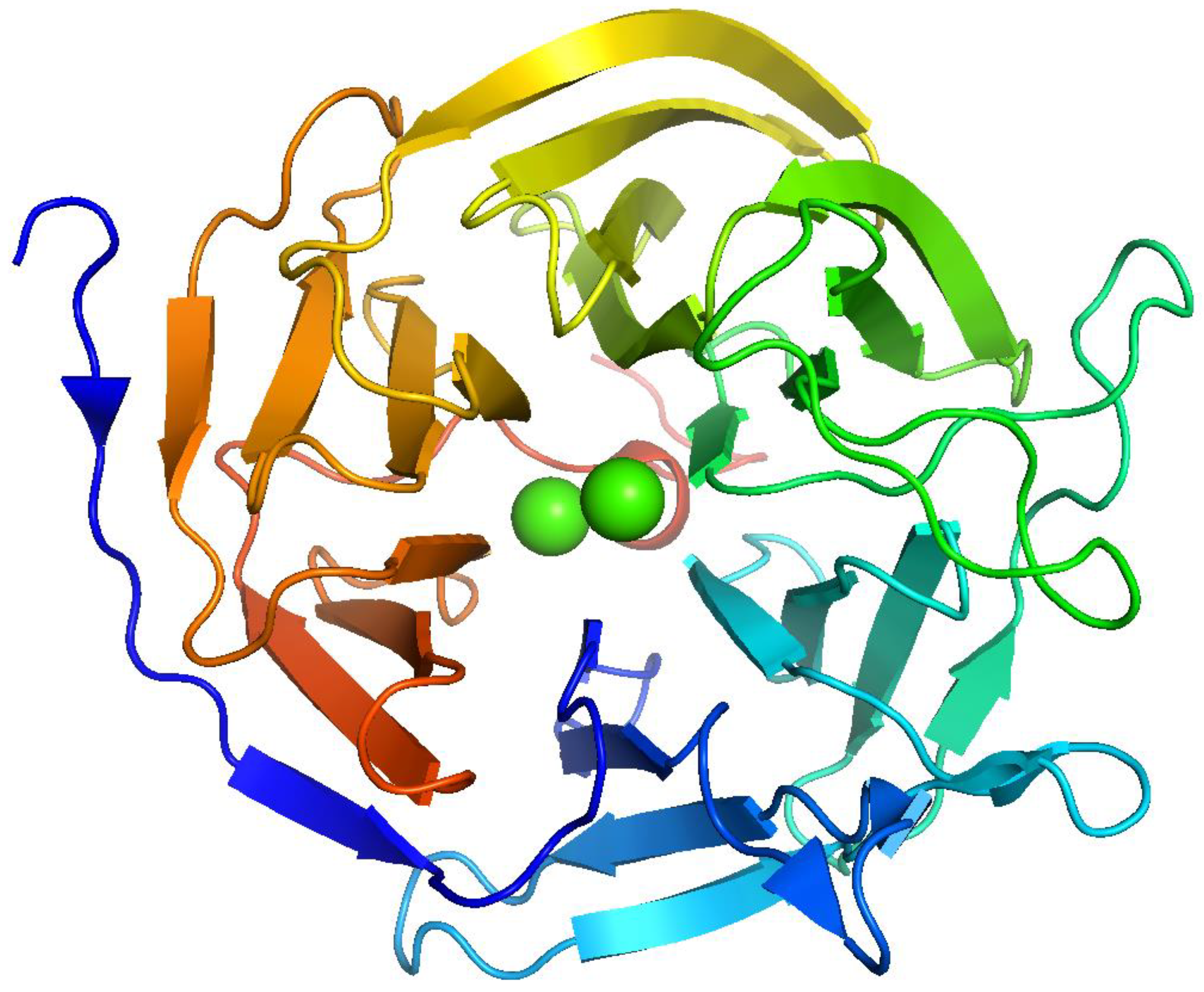

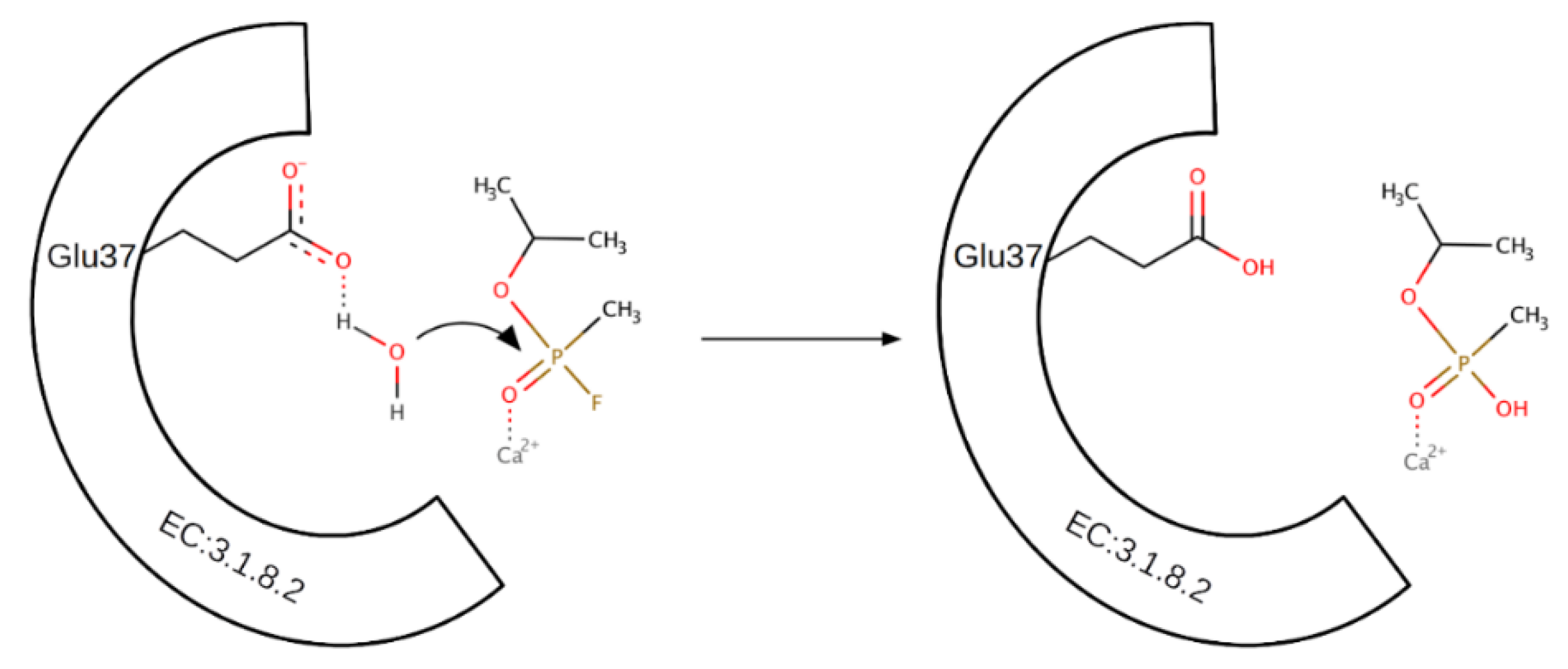

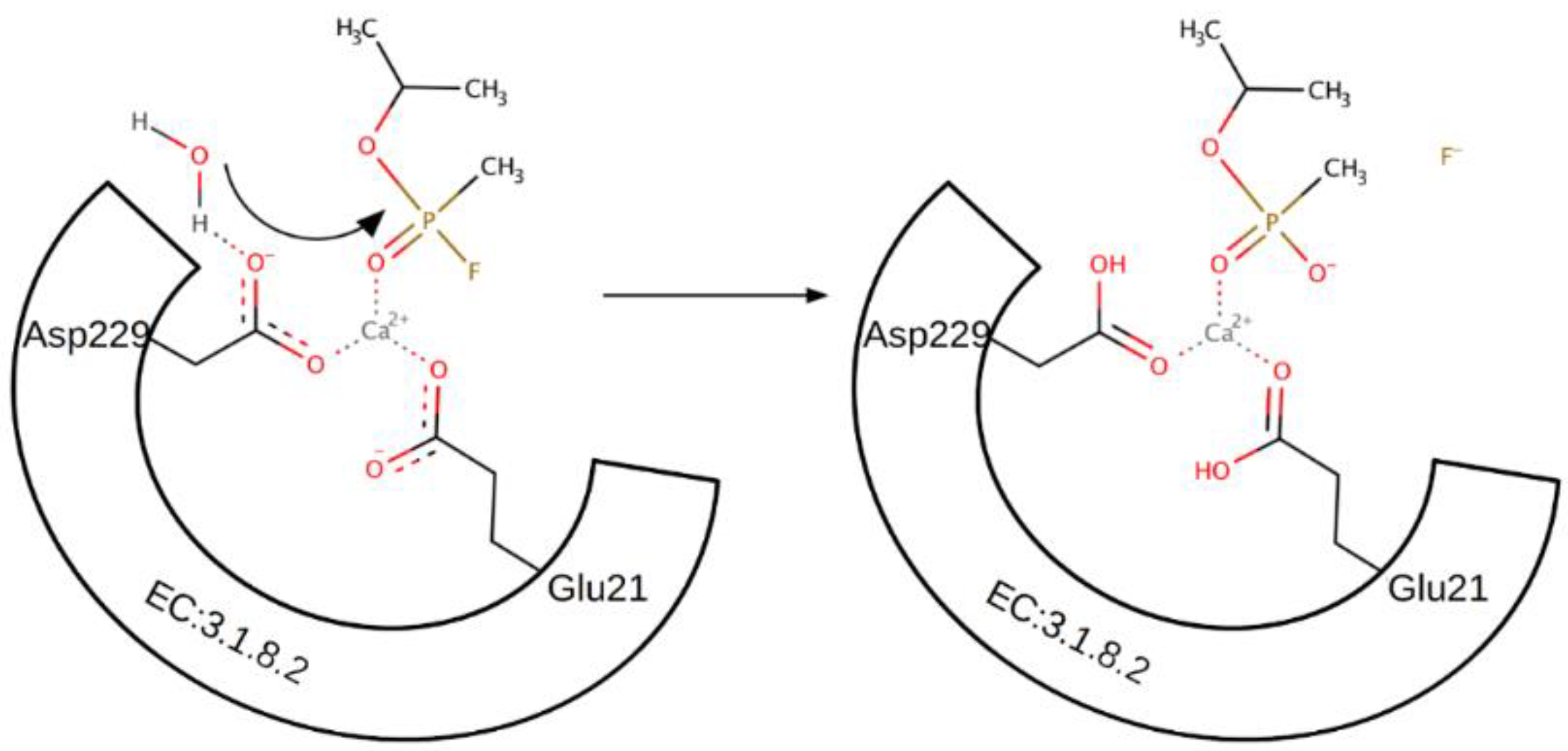
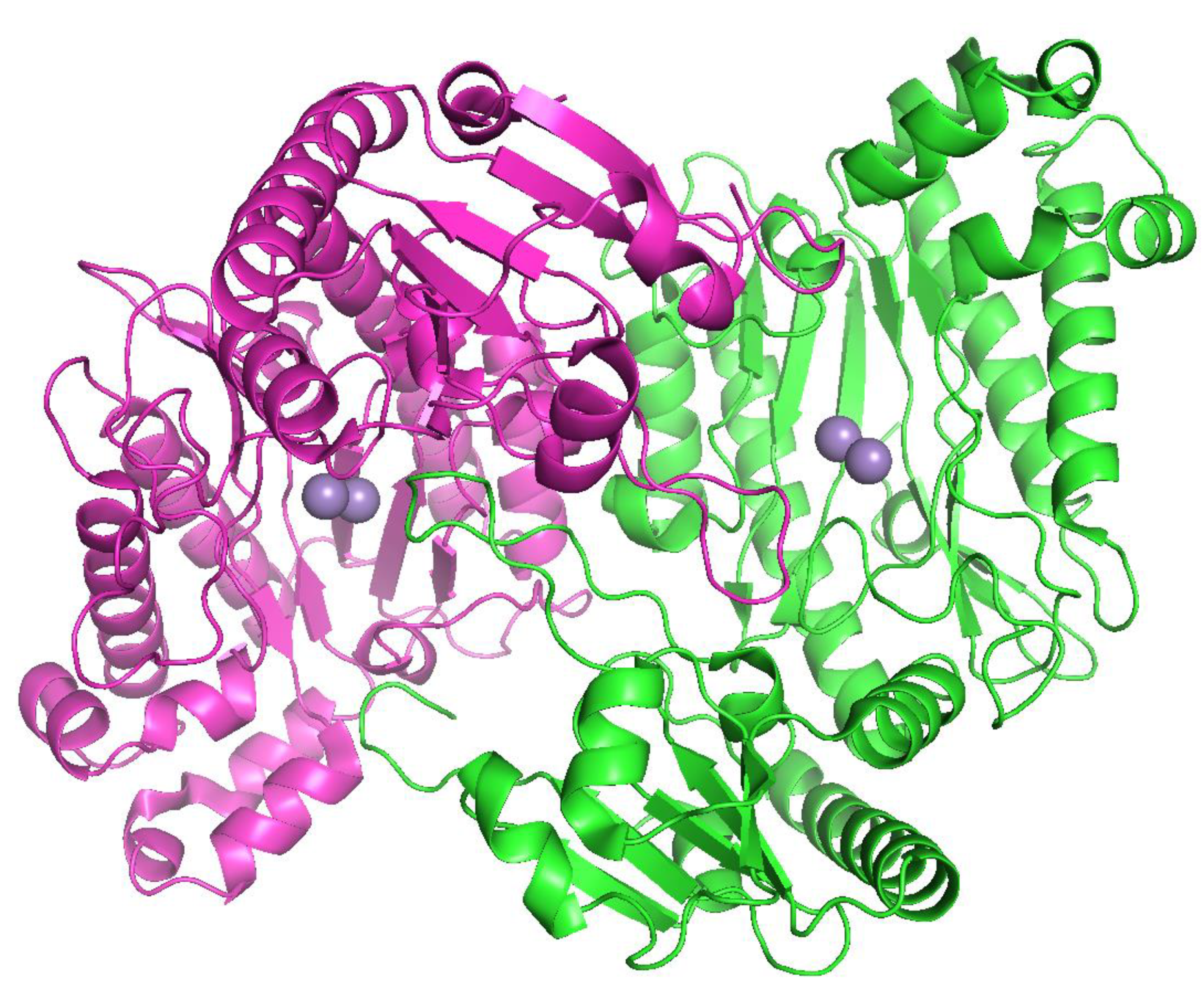
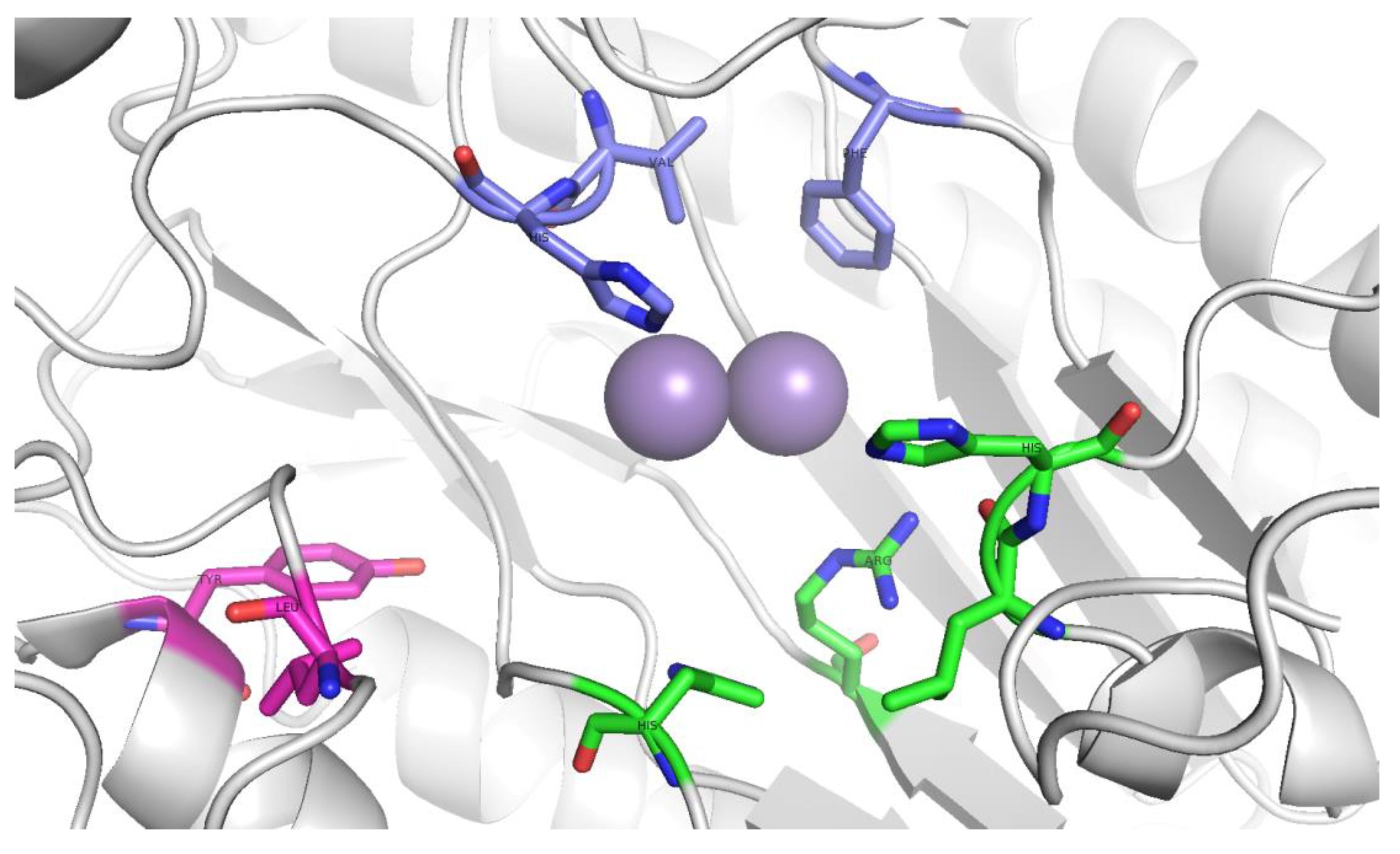
| - | Alteromonas sp. JD6.5 | Alteromonas haloplanktis | Alteromonas undina |
|---|---|---|---|
| Molecular weight (kDa) | 60 | 50 | 53 |
| Metal requirement | Mn or Co | Mn | Mn |
| Temperature optimum (°C) | 50 | 40 | 55 |
| pH optimum | 8.5 | 7.5 | 8.0 |
| Agent/Source | Alteromonas undina | Alteromonas haloplanktis | Alteromonas sp. JD6.5 |
|---|---|---|---|
| DFP | 1403 | 691 | 1820 |
| tabun | 368 | 255 | 85 |
| sarin | 426 | 308 | 611 |
| soman | 2826 | 1667 | 3145 |
| cyclosarin | 1775 | 323 | 1654 |
| Substrate | kcat/Km (M−1·min−1) |
|---|---|
| DFP | 3.7 × 107 |
| soman | 1.6 × 107 |
| GP | 1.3 × 107 |
| sarin | 1.3 × 106 |
| novichok A230 | 9.5 × 104 |
| novichok A232 | 6.9 × 104 |
| novichok A234 | 3.5 × 104 |
| VR | 5.4 × 102 |
| Source | Genotype | Abbreviation |
|---|---|---|
| OPAA | Tyr212Phe/Val342Leu | FL |
| OPAA | Tyr212Phe/Val342Ile | FI |
| OPAA | Tyr212 Phe/Val342Tyr | FY |
| Enzyme and Substrate | kcat/Km (min−1 M−1) | kcat/Km FL/WT |
|---|---|---|
| WT on sarin | 1.33 × 106 | |
| FL on sarin | 8.50 × 106 | 6.4 |
| FI on sarin | 2.72 × 106 | 2.0 |
| FY on sarin | 1.96 × 106 | 1.5 |
| WT on soman | 1.61 × 107 | |
| FL on soman | 7.48 × 107 | 4.6 |
| WT on GP | 1.29 × 107 | |
| FL on GP | 1.29 × 108 | 10.0 |
| Enzyme | Genotype | kcat/Km (min−1 M−1) |
|---|---|---|
| WT | Wild-type | 548 ± 128 |
| F | Tyr212Phe | 2451 ± 540 |
| FL | Tyr212Phe/Val342Leu | 11,894 ± 2349 |
| FLY | Tyr212Phe/Val342Leu/Ile215 Tyr | 19,642 ± 6071 |
| FLYD | Tyr212Phe/Val342Leu/Ile215Tyr/His343Asp | 8890 ± 258 |
Publisher’s Note: MDPI stays neutral with regard to jurisdictional claims in published maps and institutional affiliations. |
© 2020 by the authors. Licensee MDPI, Basel, Switzerland. This article is an open access article distributed under the terms and conditions of the Creative Commons Attribution (CC BY) license (http://creativecommons.org/licenses/by/4.0/).
Share and Cite
Matula, M.; Kucera, T.; Soukup, O.; Pejchal, J. Enzymatic Degradation of Organophosphorus Pesticides and Nerve Agents by EC: 3.1.8.2. Catalysts 2020, 10, 1365. https://doi.org/10.3390/catal10121365
Matula M, Kucera T, Soukup O, Pejchal J. Enzymatic Degradation of Organophosphorus Pesticides and Nerve Agents by EC: 3.1.8.2. Catalysts. 2020; 10(12):1365. https://doi.org/10.3390/catal10121365
Chicago/Turabian StyleMatula, Marek, Tomas Kucera, Ondrej Soukup, and Jaroslav Pejchal. 2020. "Enzymatic Degradation of Organophosphorus Pesticides and Nerve Agents by EC: 3.1.8.2" Catalysts 10, no. 12: 1365. https://doi.org/10.3390/catal10121365
APA StyleMatula, M., Kucera, T., Soukup, O., & Pejchal, J. (2020). Enzymatic Degradation of Organophosphorus Pesticides and Nerve Agents by EC: 3.1.8.2. Catalysts, 10(12), 1365. https://doi.org/10.3390/catal10121365






